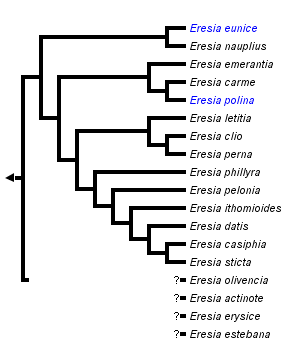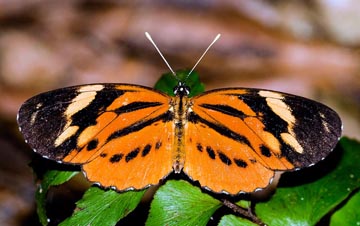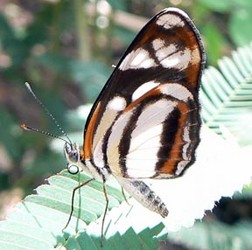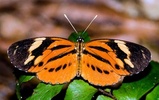Eresia
Andrew V. Z. Brower


This tree diagram shows the relationships between several groups of organisms.
The root of the current tree connects the organisms featured in this tree to their containing group and the rest of the Tree of Life. The basal branching point in the tree represents the ancestor of the other groups in the tree. This ancestor diversified over time into several descendent subgroups, which are represented as internal nodes and terminal taxa to the right.

You can click on the root to travel down the Tree of Life all the way to the root of all Life, and you can click on the names of descendent subgroups to travel up the Tree of Life all the way to individual species.
For more information on ToL tree formatting, please see Interpreting the Tree or Classification. To learn more about phylogenetic trees, please visit our Phylogenetic Biology pages.
close boxIntroduction
A morphologically diverse neotropical genus. Some species are remarkable (presumably) Batesian mimics of ithomiine and heliconiine butterflies, and can often be found incorrectly curated among those taxa in museum collections.
Discussion of Phylogenetic Relationships
Phylogenetic relationships are based on the molecular analysis of Wahlberg and Freitas (2007). "Eresia" levina and "Eresia" lansdorfi do not belong to the same clade as the remainder of Eresia s. s, according to this hypothesis.
References
Higgins LG. 1981. A revision of Phyciodes Hubner and related genera, with a review of the classification of the Melitaeinae (Lepidoptera: Nymphalidae). Bulletin of the British Museum (Natural History) 43: 77-243.
Lamas G ed. 2004. Atlas of Neotropical Lepidoptera. Checklist: Part 4A Hesperioidea - Papiionoidea. Gainesville: Scientific Publishers/Association of Tropical Lepidoptera.
Wahlberg, N. & Freitas, A. V. 2007 Colonization of and radiation in South America by butterflies in the subtribe Phyciodina (Lepidoptera: Nymphalidae). Molecular Phylogenetics and Evolution 44, 1257-1272.
Title Illustrations

| Scientific Name | Eresia eunice |
|---|---|
| Location | Peru: Rio Tambopata, Posadas Amazonas |
| Specimen Condition | Live Specimen |
| Identified By | Rick Cech |
| Life Cycle Stage | adult |
| View | dorsal |
| Source | Eunice Crescent (Eresia eunice) |
| Source Collection | Neotropical Butterflies |
| Copyright | © 2006 Rick Cech |
| Scientific Name | Eresia clio |
|---|---|
| Location | Mexico: Chiapas |
| Specimen Condition | Live Specimen |
| Identified By | Barbara Ribble |
| Life Cycle Stage | adult |
| View | ventral |
| Source | Clio Crescent (Eresia clio) |
| Source Collection | Neotropical Butterflies |
| Copyright | © 2006 Barbara Ribble |
About This Page

Middle Tennessee State University, Murfreesboro, Tennessee, USA
Correspondence regarding this page should be directed to Andrew V. Z. Brower at
Page copyright © 2007
 Page: Tree of Life
Eresia .
Authored by
Andrew V. Z. Brower.
The TEXT of this page is licensed under the
Creative Commons Attribution License - Version 3.0. Note that images and other media
featured on this page are each governed by their own license, and they may or may not be available
for reuse. Click on an image or a media link to access the media data window, which provides the
relevant licensing information. For the general terms and conditions of ToL material reuse and
redistribution, please see the Tree of Life Copyright
Policies.
Page: Tree of Life
Eresia .
Authored by
Andrew V. Z. Brower.
The TEXT of this page is licensed under the
Creative Commons Attribution License - Version 3.0. Note that images and other media
featured on this page are each governed by their own license, and they may or may not be available
for reuse. Click on an image or a media link to access the media data window, which provides the
relevant licensing information. For the general terms and conditions of ToL material reuse and
redistribution, please see the Tree of Life Copyright
Policies.
- First online 11 March 2007
- Content changed 21 January 2008
Citing this page:
Brower, Andrew V. Z. 2008. Eresia . Version 21 January 2008 (under construction). http://tolweb.org/Eresia/70584/2008.01.21 in The Tree of Life Web Project, http://tolweb.org/









 Go to quick links
Go to quick search
Go to navigation for this section of the ToL site
Go to detailed links for the ToL site
Go to quick links
Go to quick search
Go to navigation for this section of the ToL site
Go to detailed links for the ToL site